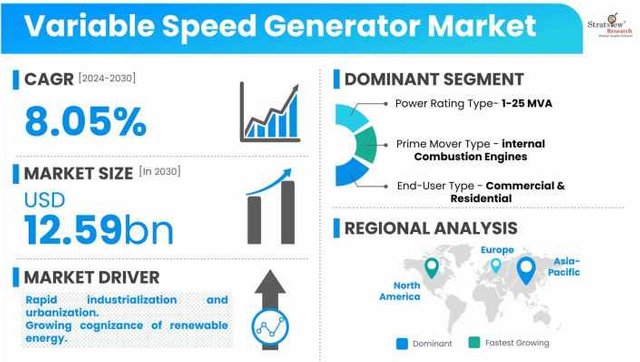Variable Speed Generators: Market Dynamics and Opportunities for 2024 and Beyond
The global variable speed generator market is on the cusp of significant growth, driven by rising demand for energy efficiency, expanding renewable energy adoption, and ongoing technological advancements. variable speed generators, which adjust their output speed based on fluctuating power requirements, are becoming critical components in both industrial and energy sectors due to their ability to improve efficiency and reduce energy waste. As we look toward 2024 and beyond, understanding the market dynamics and emerging opportunities for variable speed generators is essential for businesses and investors.
According to Stratview Research, the variable speed generator market was estimated at USD 7.3 billion in 2022 and is likely to grow at a CAGR of 8.05% during 2024-2030 to reach USD 12.59 billion in 2030.

Key Market Dynamics
1. Energy Efficiency Mandates: With increasing global pressure to reduce energy consumption and minimize carbon emissions, regulatory bodies are tightening energy efficiency standards across industries. Variable speed generators, which optimize power output by matching supply with demand, are becoming key solutions for industries aiming to comply with these mandates. This trend is driving demand for variable speed generators in sectors such as manufacturing, transportation, and oil & gas, where energy efficiency directly impacts operational costs and environmental performance.
2. Renewable Energy Integration: The shift toward renewable energy is a major driver for VSG market growth. Wind and hydropower systems, which operate under variable conditions, are prime candidates for variable speed generator technology. Unlike traditional generators, variable speed generators can adjust their speed in response to changing inputs, maximizing the efficiency of renewable energy generation. As governments worldwide push for increased renewable energy capacity, variable speed generators are expected to play an essential role in stabilizing and optimizing these systems.
3. Technological Innovations: Advancements in power electronics, digital controls, and smart grid technologies are enhancing the capabilities of variable speed generators. Innovations such as real-time monitoring, predictive maintenance, and automated control systems are improving reliability and reducing downtime, making variable speed generators more attractive to industries that require consistent power. These technological improvements are likely to accelerate market growth, as businesses adopt more advanced power management solutions.
Emerging Opportunities for 2024 and Beyond
1. Hybrid Energy Systems: The growing use of hybrid energy systems, which combine renewable energy with traditional power sources, offers new opportunities for variable speed generators. In these systems, variable speed generators play a crucial role in balancing power generation, reducing reliance on energy storage, and ensuring grid stability. This presents a promising market opportunity, especially in regions with remote or off-grid locations.
2. Expanding Industrial Applications: Industries are increasingly adopting variable speed generators to manage fluctuating power demands. In sectors such as mining, manufacturing, and marine operations, the ability to optimize power generation and improve fuel efficiency makes variable speed generators a valuable asset, presenting ongoing opportunities for growth.
Conclusion
As the global focus on energy efficiency and renewable energy intensifies, variable speed generators are well-positioned for growth in 2024 and beyond. With increasing regulatory pressure, technological advancements, and opportunities in hybrid systems, the variable speed generator market offers promising potential for both established players and new entrants seeking to capitalize on this evolving energy landscape.